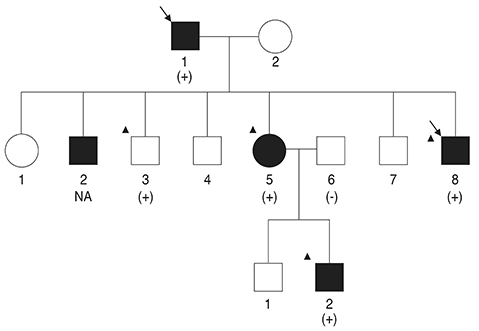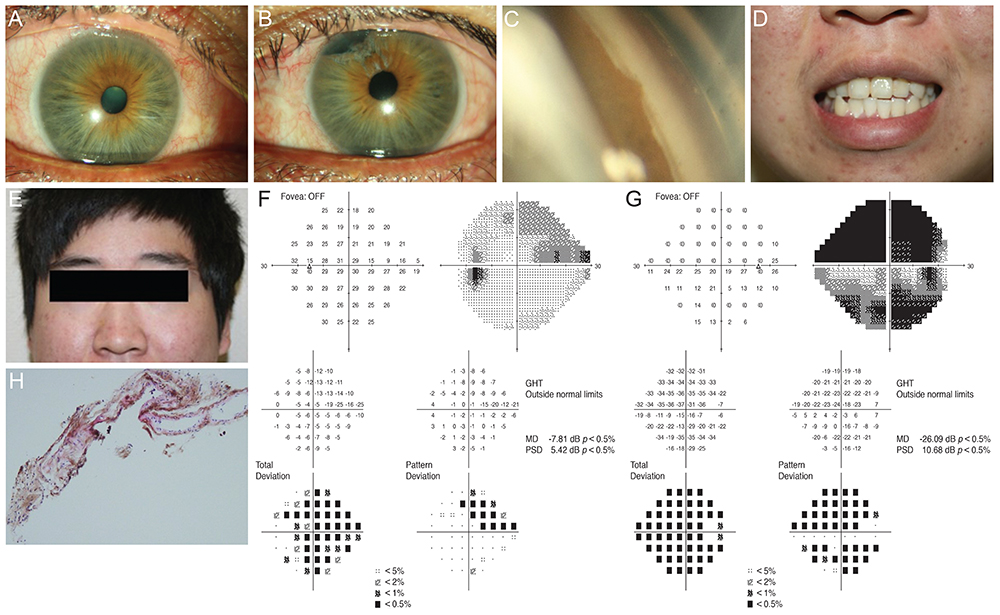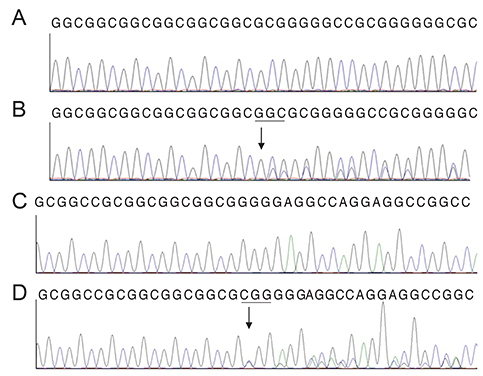Korean J Ophthalmol.
2015 Aug;29(4):249-255. 10.3341/kjo.2015.29.4.249.
A Family with Axenfeld-Rieger Syndrome: Report of the Clinical and Genetic Findings
- Affiliations
-
- 1Department of Ophthalmology, The Catholic University of Korea College of Medicine, Seoul, Korea. marypark@catholic.ac.kr
- 2Catholic Institute for Visual Science, Department of Ophthalmology and Visual Science, Seoul St. Mary's Hospital, The Catholic University of Korea College of Medicine, Seoul, Korea.
- KMID: 2363769
- DOI: http://doi.org/10.3341/kjo.2015.29.4.249
Abstract
- PURPOSE
To describe clinical findings in a Korean family with Axenfeld-Rieger syndrome.
METHODS
A retrospective review of clinical data about patients with diagnosed Axenfeld-Rieger syndrome. Five affected members of the family underwent a complete ophthalmologic examination. We screened the forkhead box C1 gene and the pituitary homeobox 2 gene in patients. Peripheral blood leukocytes and buccal mucosal epithelial cells were obtained from seven members of a family with Axenfeld-Rieger syndrome. DNA was extracted and amplified by polymerase chain reaction, followed by direct sequencing.
RESULTS
The affected members showed iris hypoplasia, iridocorneal adhesions, posterior embryotoxon, and advanced glaucoma in three generation. None had systemic anomalies. Two mutations including c.1362_1364insCGG and c.1142_1144insGGC were identified in forkhead box C1 in four affected family members.
CONCLUSIONS
This study may help to understand clinical findings and prognosis for patients with Axenfeld-Rieger syndrome.
MeSH Terms
-
Aged, 80 and over
Anterior Eye Segment/*abnormalities/metabolism
DNA/*genetics
DNA Mutational Analysis
Eye Abnormalities/diagnosis/*genetics/metabolism
Female
Forkhead Transcription Factors/*genetics/metabolism
Genetic Testing
Homeodomain Proteins/*genetics/metabolism
Humans
Male
Middle Aged
*Mutation
Pedigree
Retrospective Studies
Transcription Factors/*genetics/metabolism
Young Adult
DNA
Forkhead Transcription Factors
Homeodomain Proteins
Transcription Factors
Figure
Reference
-
1. Shields MB. Shields textbook of glaucoma. 6th ed. Philadelphia: Lippincott Williams & Wilkins;2011. p. 227–235.2. Shields MB. Axenfeld-Rieger syndrome: a theory of mechanism and distinctions from the iridocorneal endothelial syndrome. Trans Am Ophthalmol Soc. 1983; 81:736–784.3. Alward WL. Axenfeld-Rieger syndrome in the age of molecular genetics. Am J Ophthalmol. 2000; 130:107–115.4. Anderson DR. The development of the trabecular meshwork and its abnormality in primary infantile glaucoma. Trans Am Ophthalmol Soc. 1981; 79:458–485.5. Challa P. Glaucoma genetics. Int Ophthalmol Clin. 2008; 48:73–94.6. Pierrou S, Hellqvist M, Samuelsson L, et al. Cloning and characterization of seven human forkhead proteins: binding site specificity and DNA bending. EMBO J. 1994; 13:5002–5012.7. Phillips JC, del Bono EA, Haines JL, et al. A second locus for Rieger syndrome maps to chromosome 13q14. Am J Hum Genet. 1996; 59:613–619.8. Kim GN, Ki CS, Seo SW, et al. A novel forkhead box C1 gene mutation in a Korean family with Axenfeld-Rieger syndrome. Mol Vis. 2013; 19:935–943.9. Pal B, Mohamed MD, Keen TJ, et al. A new phenotype of recessively inherited foveal hypoplasia and anterior segment dysgenesis maps to a locus on chromosome 16q23.2-24.2. J Med Genet. 2004; 41:772–777.10. Riise R, Storhaug K, Brondum-Nielsen K. Rieger syndrome is associated with PAX6 deletion. Acta Ophthalmol Scand. 2001; 79:201–203.11. Tanwar M, Dada T, Dada R. Axenfeld-Rieger syndrome associated with congenital glaucoma and cytochrome P4501B1 gene mutations. Case Rep Med. 2010; 08. 09. DOI: 10.1155/2010/212656.12. Honkanen RA, Nishimura DY, Swiderski RE, et al. A family with Axenfeld-Rieger syndrome and Peters Anomaly caused by a point mutation (Phe112Ser) in the FOXC1 gene. Am J Ophthalmol. 2003; 135:368–375.13. Ito YA, Walter MA. Genomics and anterior segment dysgenesis: a review. Clin Experiment Ophthalmol. 2014; 42:13–24.14. Larsson C, Hellqvist M, Pierrou S, et al. Chromosomal localization of six human forkhead genes, freac-1 (FKHL5), -3 (FKHL7), -4 (FKHL8), -5 (FKHL9), -6 (FKHL10), and -8 (FKHL12). Genomics. 1995; 30:464–469.15. Strungaru MH, Dinu I, Walter MA. Genotype-phenotype correlations in Axenfeld-Rieger malformation and glaucoma patients with FOXC1 and PITX2 mutations. Invest Ophthalmol Vis Sci. 2007; 48:228–237.
- Full Text Links
- Actions
-
Cited
- CITED
-
- Close
- Share
- Similar articles
-
- A Case of Axenfeld-Rieger Syndrome with Severe Mitral Regurgitation
- Department of Ophthalmology, Taegu Fatima Hospital
- Novel c.300_301delinsT Mutation in PITX2 in a Korean Family with Axenfeld-Rieger Syndrome
- Anomalous Scleral Insertion of Superior Oblique in Axenfeld-Rieger Syndrome
- Two Cases of Rieger's Syndrome




